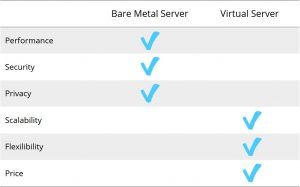We are often asked, “what is the difference between bare metal servers and virtual servers and bare metal cloud?” Followed by, which one should I use? In this article, we’ll discuss the features and benefits of bare metal servers, virtual servers, and how bare metal cloud combines some of the benefits of both.
Bare Metal Server
A bare metal server is a “single tenant” physical server. This means that the server is dedicated to one customer and not shared between multiple customers. This prevents the “noisy neighbor” problem, where server performance is impacted by other customers’ workloads.
Bare metal servers are typically used for workloads that are latency sensitive and require a large amount of raw processing power, such as rendering, gaming, large relational databases, etc.
Virtual Server
A virtual server is hosted in a “multi-tenant” environment. This is where multiple virtual servers share the same physical hardware. Virtual servers are easily scalable, but lack the performance and security of bare metal servers.
Virtual servers are commonly used for e-commerce, test and development for server applications, workload migrations, etc.
Bare Metal Server vs. Virtual Server
Choosing between a bare metal server and virtual server depends on your needs and budget.

Bare Metal Cloud
If you want on-demand access, high scalability, and pay-as-you-go features, use bare metal cloud.
According to a Forrester report (April 2015), bare metal cloud has several key advantages:
Latency-sensitive workloads
Bare metal clouds eliminate the latency associated with virtual machines and their virtualized network and I/O, one of the strongest use cases for bare-metal cloud is workloads that require the lowest latency.
Dedicated hardware with cloud features
Bare metal clouds offer a way to deploy workloads that demand dedicated hardware for performance and isolation reasons with all the operational advantages of virtual infrastructure-as-a-service cloud services.
High load Economics
Despite the continued decrease in virtual cloud pricing, bare metal clouds can be cheaper on a per-workload basis for environments where the virtual machines are large and heavily loaded on a continual basis.
Use Zenlayer’s Bare Metal Servers to deploy your bare metal cloud. You could also learn How to Build a Virtual Private Cloud Network in Zenlayer Console.







